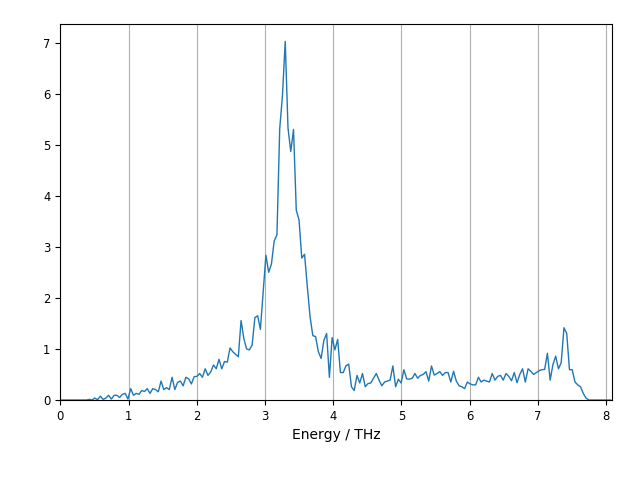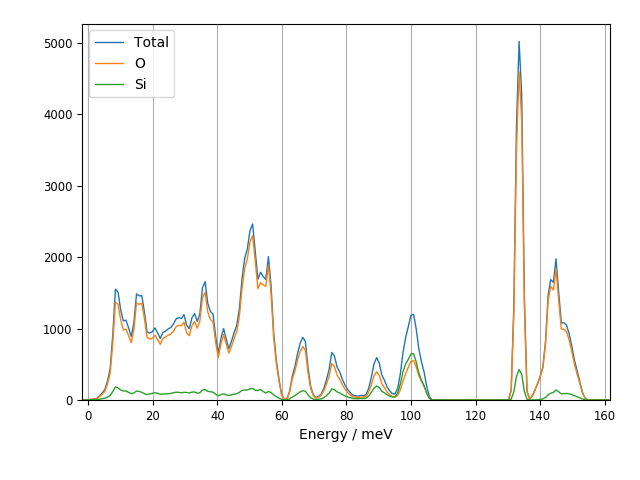euphonic-dos
The euphonic-dos program can be used to plot density of states,
partial density of states, and/or neutron-weighted density of states.
It can use pre-calculated frequencies, or use force constants to
generate frequencies and DOS over a Monkhorst-Pack grid. For example,
to plot DOS from a Phonopy mesh.yaml file in units of THz, run:
euphonic-dos NaCl/mesh.yaml --energy-unit THz

Or, to plot coherent neutron-weighted DOS from CASTEP force constants in a
.castep_bin file on a 15x15x12 grid with 1.5 meV broadening, run:
euphonic-dos quartz.castep_bin --weighting coherent-dos --grid 15 15 12 --energy-broadening 1.5

To see all the command line options, run:
euphonic-dos -h
You can also see the available command line options below. For information on advanced plot styling, see Customising plots.
Command Line Options
Plots a DOS from the file provided. If a force constants file is provided, a DOS is generated on the Monkhorst-Pack grid specified by the grid (or grid-spacing) argument.
usage: euphonic-dos [-h] [--asr [{reciprocal,realspace}]]
[--dipole-parameter DIPOLE_PARAMETER]
[--use-c | --disable-c] [--n-threads N_THREADS]
[--pdos [PDOS [PDOS ...]]]
[--weighting {dos,coherent-dos,incoherent-dos,coherent-plus-incoherent-dos}]
[--grid GRID GRID GRID | --grid-spacing GRID_SPACING]
[--scale SCALE] [--save-json SAVE_JSON] [-s SAVE_TO]
[--title TITLE] [--x-label XLABEL] [--y-label YLABEL]
[--style STYLE [STYLE ...]] [--no-base-style]
[--font FONT] [--font-size FONTSIZE]
[--fig-size FIGSIZE FIGSIZE]
[--fig-size-unit FIGSIZE_UNIT] [--line-width LINEWIDTH]
[--e-min E_MIN] [--e-max E_MAX]
[--energy-unit ENERGY_UNIT] [--ebins EBINS] [--adaptive]
[--adaptive-method {reference,fast}]
[--adaptive-error ADAPTIVE_ERROR]
[--adaptive-scale ADAPTIVE_SCALE]
[--adaptive-fit {cubic,cheby-log}]
[--instrument-broadening INST_BROADENING [INST_BROADENING ...]]
[--energy-broadening ENERGY_BROADENING [ENERGY_BROADENING ...]]
[--shape [{gauss,lorentz}]] [--length-unit LENGTH_UNIT]
filename
File I/O arguments
- filename
Phonon data file. This should contain force constants or phonon mode data. Force constants formats: .yaml, force_constants.hdf5 (Phonopy); .castep_bin , .check (Castep); .json (Euphonic). Phonon mode data formats: {band,qpoints,mesh}.{hdf5,yaml} (Phonopy); .phonon (Castep); .json (Euphonic)
- --save-json
Save spectrum to a .json file with this name
q-point sampling arguments
- --grid
Defines a Monkhorst-Pack grid.
- --grid-spacing
q-point spacing of Monkhorst-Pack grid.
Default: 0.1
- --length-unit
Length units; these will be inverted to obtain units of distance between q-points (e.g. “bohr” for bohr^-1).
Default: “angstrom”
energy/frequency arguments
- --e-min
Energy range minimum in ENERGY_UNIT
- --e-max
Energy range maximum in ENERGY_UNIT
- --energy-unit, -u
Energy units
Default: “meV”
- --ebins
Number of energy bins
Default: 200
- --adaptive
Use adaptive broadening on the energy axis to broaden based on phonon mode widths, rather than using fixed width broadening
Default: False
- --adaptive-method
Possible choices: reference, fast
Adaptive broadening method. “Reference” is default for compatibility purposes: “Fast” method is approximate with much better performance.
Default: “reference”
- --adaptive-error
Maximum absolute error for gaussian approximations when using the fast adaptive broadening method
Default: 0.01
- --adaptive-scale
Scale factor applied to adaptive broadening width
- --adaptive-fit
Possible choices: cubic, cheby-log
Select parametrisation for fast adaptive broadening. “cheby-log” is generally recommended, “cubic” is default retained for backward-compatibility. This only applies when adaptive broadening is used; if variable-width instrument broadening is used alone then “cheby-log” will be used.
Default: “cubic”
- --instrument-broadening
The FWHM of broadening on energy axis in ENERGY_UNIT (no broadening if unspecified). If multiple values are provided, these will be interpreted as polynomial coefficients to be evaluated in ENERGY_UNIT base, e.g. –energy-broadening 1. 0.01 1e-6 –energy-unit meV will apply FWHM of (1. + 0.01 (energy / meV) + 1e-6 (energy / meV)^2) meV.
- --energy-broadening, --eb
If using adaptive broadening and a single (i.e. scalar) value is provided, this is an alias for –adaptive-scale. Otherwise, this is an alias for –instrument-broadening.
- --shape
Possible choices: gauss, lorentz
The broadening shape
Default: “gauss”
Force constants interpolation arguments
- --asr
Possible choices: reciprocal, realspace
Apply an acoustic-sum-rule (ASR) correction to the data: “realspace” applies the correction to the force constant matrix in real space. “reciprocal” applies the correction to the dynamical matrix at each q-point.
- --dipole-parameter
Set the cutoff in real/reciprocal space for the dipole Ewald sum; higher values use more reciprocal terms. If tuned correctly this can result in performance improvements. See euphonic-optimise-dipole-parameter program for help on choosing a good DIPOLE_PARAMETER.
Default: 1.0
Property-calculation arguments
- --pdos
Plot PDOS. With –pdos, per-species PDOS will be plotted alongside total DOS. A subset of species can also be selected by adding more arguments e.g. –pdos Si O
- --weighting, -w
Possible choices: dos, coherent-dos, incoherent-dos, coherent-plus-incoherent-dos
Type of DOS to plot: DOS, coherent neutron-weighted DOS, incoherent neutron-weighted DOS or total (coherent + incoherent) neutron-weighted DOS
Default: “dos”
- --scale
Intensity scale factor
Plotting arguments
- -s, --save-to
Save resulting plot to a file with this name
- --title
Plot title
Default: “”
- --x-label, --xlabel
Plot x-axis label
- --y-label, --ylabel
Plot y-axis label
- --style
Matplotlib styles (name or file)
- --no-base-style
Remove all default formatting before applying other style options.
Default: False
- --font
Select text font. (This has to be a name known to Matplotlib. font-family will be set to sans-serif; it doesn’t matter if)the font is actually sans-serif.
- --font-size, --fontsize
Set base font size in pt.
- --fig-size, --figsize
Figure canvas size in FIGSIZE-UNITS
- --fig-size-unit, --figsize-unit
Unit of length for –figsize
Default: “cm”
- --line-width, --linewidth
Set line width in pt.